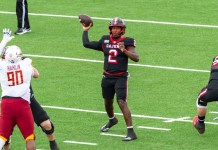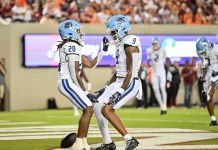College Football Power Ratings Model:
The process of creating a rating system for college football teams is different for everybody. It can be as detailed or basic as the creator wants it to be and the form and function will also vary. The vast majority of people who bet on sports won’t have any ratings system at all or will simply crowdsource opinions from the ones that already exist.
There is nothing wrong with that and your process for coming to a wager should be whatever makes you confident and comfortable. However, your process should also be flexible. If bets aren’t going your way or you are consistently taking bad numbers because the line moved against you, it would be a good idea to consider some changes.
Like everything else with present-day college football, it is getting increasingly more difficult to pin down players and teams. Continuity is almost non-existent, as players and coaches rack up travel miles by moving all over the country. Also, transfers are moving from the FCS ranks to the Group of Five and Power Five ranks, while Group of Five players are also leveling up to Power Five. Players that had success at lower levels aren’t a guarantee to have success at the highest level or in a new scheme.
So, creating your own set of college football power ratings might seem like a real challenge. Like I said, you can be as detailed or as basic as you want to be. My chief goal in using power ratings in my handicapping is to get some line value by betting early in the week. If my line is +4 and the line comes out at +7.5, I want to take that +7.5 and then see that line move closer to +4. But, if I don’t know where I think the line should be, then it is much harder to justify betting earlier in the week.
The truth is a very high percentage of football bettors only bet on game day or the day before. There may only be a few instances per season where not getting the best of the line or better than where the line closes makes the difference, but the practice of getting closing line value, or CLV, is one of the best indicators of future betting success. That means you get a better line than what the line is at kickoff.
I have friends and colleagues in the industry, including our very own Tyler Shoemaker and his T Shoe Index, and Steve Makinen, whose power ratings and game lines are available on our website, who have extremely detailed power ratings or betting models. For the purposes of our College Football Betting Guide, though, I want to illustrate a down-and-dirty power ratings setup that can help you this season.
These are what I’d call “Positional Power Ratings” and are based on a scale of roughly 40-100. The worst teams in the nation will be closer to 40. The best teams will be closer to 100. Quarterback, offensive line, defensive line, coaching/special teams are worth a maximum of 15 points each (60 total). Running back, wide receiver, linebackers, and defensive backs are worth a maximum of 10 points each (40 total). The stronger the position group, the higher the value. I determine these values based on my perceptions of national strength and conference strength, but that’s where the art part comes in against the science part.
Then, I take Team vs. Team and apply my home-field advantage numbers to put together a spread on that game. If my line is off from the market, I will consider that accordingly.
As the season goes along, I will adjust team values accordingly based on the closing line, the line movement, and the game result from studying the box score. In the lead-up to the season, I’m using these to look for season win total bets.
Georgia (95) is the top team in the nation for me, but since I did this exercise with them last season, let’s look at the No. 2 Ohio State Buckeyes.
Quarterback (13.5/15)
Will Howard might be the perfect QB for Chip Kelly’s offense, but I don’t know that yet. He accumulated just over 3,000 total yards with 34 total TD and 10 INT. The Buckeyes are deep with freshman Air Noland and transfer Julian Sayin. I wouldn’t call this an elite group, but it’s certainly a good one.
Running Back (10/10)
A backfield with TreVeyon Henderson and Quinshon Judkins might be the best in the nation. Henderson will cross 3,000 rushing yards for his career this season even if he shares a lot of carries with Judkins, who has 31 TD and over 2,700 yards to his name in just two college seasons. The Buckeye backfield has 63 career TD between these two and Kelly’s run scheme. That merits a top grade.
Wide Receiver (10/10)
Carnell Tate and Brandon Inniss are actually the wild cards here. We know Emeka Egbuka is solid and freshman Jeremiah Smith absolutely looks like the real deal and next big star at WR. The Buckeyes do need a WR3 to emerge and also lost a very good TE in Cade Stover. Still, the upside and potential of this unit is tremendous and so is WR coach Brian Hartline.
Offensive Line (12.5/15)
With all the options at QB, I think one will emerge there. This is the position group with the most questions to me. The Buckeyes were 79th in yards per carry last season and tied for 46th in sacks. Alabama C Seth McLaughlin and three returning starters should help.
Defensive Line (14/15)
JT Tuimoloau is a beast and Jack Sawyer is one of many who stayed around in hopes of getting some gold pants for beating Michigan and possibly winning a title. Tyleik Williams is a great run-stopper. This was a top-25 run defense last season under Jim Knowles and should be again.
Linebacker (9/10)
Ohio State lost tackle leaders Steele Chambers and Tommy Eichenberg, but I think they’re more athletic at linebacker for this season. Cody Simon had 12 tackles in the loss to Missouri in the Cotton Bowl and the Buckeyes have converted two safeties to LB.
Defensive Backs (10/10)
Ohio State landed star transfer Caleb Downs, who many regarded as the top transfer in the nation. He is the only starter who wasn’t one in this secondary last season. The Buckeyes allowed 145 passing yards per game last season, as the Knowles scheme took hold in Year 2. This is in the running for the best secondary in the country.
Coaching/Special Teams (14/15)
Ryan Day can’t seem to beat Michigan, but he finally realized that he shouldn’t be calling plays. Chip Kelly now has that honor and it was eminently clear what Jim Knowles’ scheme can do on defense. The talent is better here, but Day surrendering the play calling might be the biggest upgrade of the offseason for the Buckeyes.
Total: 93/100
To put this into context, here are my top 10 teams:
Georgia 95; Ohio State 93; Oregon 91.5; Texas 90; Alabama 89; Notre Dame 86; Ole Miss 86; LSU 85; Florida State 84.5, Penn State 84.5
And my bottom 10 teams:
Temple 44; New Mexico 45; Kent State 45; Kennesaw State 45; FIU 45.5; Akron 46; UTEP 46; Louisiana-Monroe 47; UMass 47; Eastern Michigan 48






